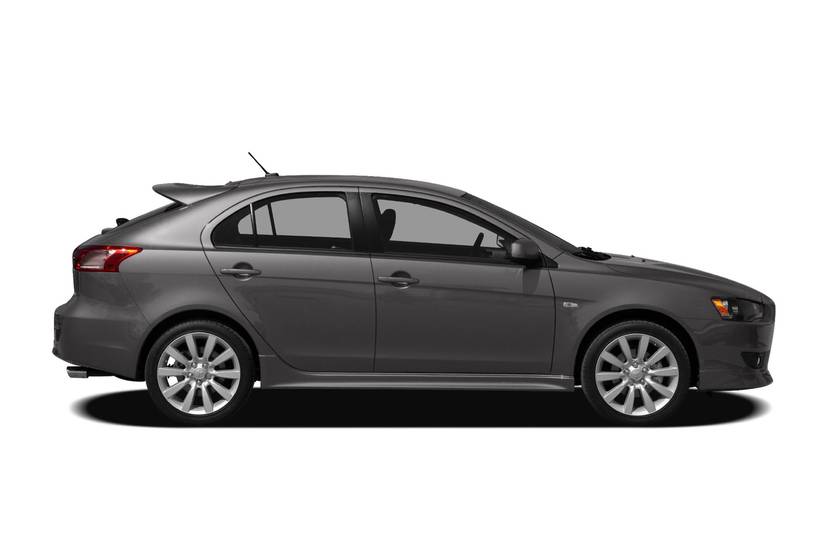
Some packaging combinations — think wine in a box — are questionable at best, but Mitsubishi’s new Lancer Sportback is a combination that’s safe to call a success. Blending the sporty shape of a coupe with the functionality of a four-door hatchback, the Lancer Sportback has plenty of style to go along with its versatility. It’s also a lot of fun to drive when equipped with the standard manual transmission, making it a legitimate alternative to cars like the Mazda3 and Subaru Impreza.
The Look
The current-generation Lancer sedan has been sold since early 2007. (See a side-by-side comparison of the 2010 Lancer Sportback and sedan.) Mitsubishi has resurrected the Sportback name for 2010, but the new model looks completely different from the one sold in the U.S. as a 2004 model. Whereas that car was essentially a wagon version of that era’s Lancer, the 2010 Lancer Sportback is more of a fastback hatchback.
Unlike traditional vertical liftgates, the Sportback’s hatch is raked forward, giving it a unique appearance among hatchbacks. The base GTS trim, which is the model I tested, has a standard spoiler above the rear window and 18-inch alloy wheels, both of which enhance the car’s sporty appearance.
When I first saw the Sportback I thought it was missing something; the car’s design made it seem like its trunklid had been lopped off. I still think the car looks a little truncated, but I give Mitsubishi credit for taking a risk with the Sportback’s styling rather than creating just another traditional hatchback.
Ride & Handling
It’s not especially difficult to firm up a car’s suspension and call it a sport model, but doing so doesn’t guarantee driving it will be fun — just look at the Toyota Corolla XRS.
Automakers that do sporty cars well understand that both ride comfort and an entertaining driving experience are important. BMW has been successful at this in the luxury realm with models like the 3 Series, while the Mazda3 has carried the torch among small cars. The Lancer Sportback reminds me a lot of the Mazda3 because its chassis and steering tuning encourage you to have a little fun when the road bends.
While the Lancer Sportback’s suspension tuning is on the firm side — it definitely gives you a feel for the road — it’s not so firm that it’ll grate on your nerves. Overall, the suspension does a nice job managing body motions while still allowing the car to have a playful, lively feel to it.
The nimble chassis is complemented by its quick-reacting steering. The standard leather-wrapped wheel feels nice in your hands, and there’s a good amount of power assistance, which means you don’t have to put a lot of effort into turning the wheel.
It can get a little loud in the cabin at highway speeds. Both road and wind noise contribute to the din, and backseat passengers will hear wind noise generated by the roof spoiler, which is right above their heads.
Going & Stopping
The Lancer Sportback’s 168-horsepower, 2.4-liter four-cylinder engine offers energetic acceleration that should satisfy all but the most power-hungry drivers. For them, Mitsubishi offers a Ralliart edition of the Sportback that’s powered by a 237-hp, turbocharged engine.
The base 2.4-liter is smooth-revving. It doesn’t protest when you wind it out — which I found myself doing often — and it really hits its stride around 4,000 rpm, where it pulls with more authority.
This engine teams with a five-speed manual or an optional continuously variable automatic transmission. The manual shifter moves precisely through the gears, and its throws are short. The light clutch pedal is easy on your leg, and it engages easily, which makes for smooth takeoffs. The EPA-estimated gas mileage is 20/27 mpg city/highway with the manual and 21/27 mpg with the automatic.
The brake pedal offers more travel than most, which might be a little alarming the first time you have to make a panic stop; the pedal goes down quite a bit before hard braking occurs. There’s a benefit to this, though, which is that it gives you a lot of control over the car’s braking performance, allowing you to fine-tune your braking.
Interior Design & Comfort
Mitsubishi has taken a minimalist approach with the Lancer Sportback’s cabin styling, and some places it works while in others it doesn’t. While the dashboard has an uncluttered, simple look that’s appealing, the few buttons there to control the optional Rockford Fosgate stereo make it harder to use than it should be. Rather than being able to directly select the radio band you want, there’s only one button to cycle through a few FM bands, four satellite bands and an AM one. If you accidently cycle past AM, for example, you have to press the button a bunch of times to get back to it.
As for materials and the quality of the controls, the Lancer Sportback is closer to the best among compact cars than it is to the worst. There are a few instances of low-grade-looking plastic — like the grab handles for closing the doors — but they don’t notably diminish what Mitsubishi has done overall, which is craft an appealing interior for its compact car.
Our test car came with optional heated leather front seats. The bucket seats have sizable side bolsters to keep you in place, but the wide seat cushions mean they don’t hug your torso unnecessarily tightly. The manual controls for the driver’s seat include height adjustment, and I was able to find a comfortable driving position. The backseat is roomy enough for adults, but don’t expect a lot of extra space. Backseat headroom is good.
Cargo
There’s 13.8 cubic feet of cargo room in the Lancer Sportback, which is marginally larger than the sedan’s 12.3-cubic-foot trunk. The Sportback’s cargo area is notably smaller than the Mazda3 hatchback’s and Impreza hatchback’s, which measure 17 and 19 cubic feet, respectively. However, when the backseat is folded, the Sportback’s expanded cargo space is the largest of the three, at 46.6 cubic feet. (The Mazda3 offers 42.8 while the Impreza manages 44.4.)
The Sportback’s liftgate opens wide and high. The 60/40-split backseat is spring-loaded, so when you pull one of the release levers in the cargo area the backrest flops forward until it’s flat with the cargo floor. Simple.
Safety
Standard safety features include antilock brakes, side-impact airbags for the front seats, side curtain airbags for both rows, a knee airbag for the driver, and an electronic stability system. For additional safety-feature information, check out the Standard Equipment & Specs page.
Lancer Sportback in the Market
What’s likely going to draw shoppers to the Sportback is its styling, which notably departs from the hatchback norm. There’s a lot more to the car than looks, though, which is why it compares favorably with the Mazda3 and Impreza hatchbacks. On the whole, it’s a well-executed addition to Mitsubishi’s Lancer lineup.
| Send Mike an email |






































